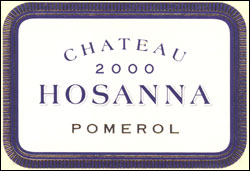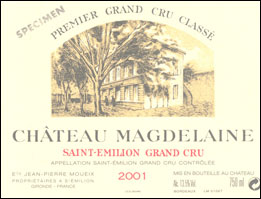Perhaps people who spend their entire life with Merlot become like the wine: easy-going and charming, without hard edges. That describes Christian Moueix, a man who is remarkably straightforward, especially for someone so important and influential in the world of wine. His intelligence and insight were immediately apparent during a wide-ranging, three-hour meeting and tasting in my kitchen last month.
The son of Jean-Pierre Moueix, Christian oversees the family's ten properties in Pomerol and St. Émilion, including Château Pétrus and Château Trotanoy, and runs a Napa Valley winery, Dominus Estate. The family company also manages and consults with many other châteaux situated on the right bank of Bordeaux's Gironde River.
This article, the first of two about Christian Moueix, focuses on his family's properties in Bordeaux and issues related to that great region. Part two, which will appear next month, focuses on Dominus Estate.
Although he was in the US for one of his usual trips to oversee Dominus, his mind was not far from Pomerol. Very involved in the day-to-day running of his family's French properties, Christian watched the weather reports in France while in the US and called home frequently to direct viticultural practices in preparation for a heat wave. "When a heat wave is predicted, it is very important to afford the grapes maximal shade by not trimming the canopy of the vines. Keeping the grapes cool is essential," according to Moueix. He thinks that part of the reason his family's properties did so well in 2003--a scorching year--was an unsightly but beautifully functional canopy.
The other major factor contributing to their success in 2003 was reliance on Merlot, which grows well in clay soils that retain water well. Even their Merlot vines planted on limestone, a less water-retentive soil, did well because they are old enough to have developed very deep root systems in search of water. Not everyone in Pomerol in 2003 was so lucky. Château Le Pin, for example, bottled no wine in 2003; the locals referred to it as Le Pin Grillé (literally, grilled) because the grapes were so roasted.
Moueix also offered an illuminating assessment of so-called "garage wines"--expensive wines made in very limited quantities at small production facilities. He believes that a garage wine is defined not just by small production but also by a lack of reliance on terroir. If size were the only criteria, all the châteaux of Pomerol would qualify because of their microscopic production. Despite its tiny production from 5 acres of vineyard, Moueix does not regard Château Le Pin as a garage wine because of its unique location.
He is optimistic that garage wines will not take over the world. In fact, he believes that consumers' infatuation with these wines will fade because they are finding that these wines do not develop with age. His older brother Jean-François, who owns retail wine shops in Bordeaux and has a good pulse on consumer reactions, sees sales of these wines dropping. And in the US, prices for La Mondotte and Château de Valendraud, (two garage wines praised highly in American publications) have fallen dramatically.
 Moueix vehemently disagrees with those who consider Château Hosanna (one of his newer properties in Pomerol) a garage wine, contending that it does not fit the mold due to its well-defined terroir. The property, which formerly was named Château Certan Giraud, has venerable vines in its well-established vineyard. When he purchased it in 1999, the Giraud family asked him not to use the Giraud name, and he--being a pragmatist--agreed. Since he already owned a brand called Certan, he considered calling it Château Certan. As a courtesy, however, he visited neighboring properties bearing "Certan" in their names to seek approval from their proprietors.
Moueix vehemently disagrees with those who consider Château Hosanna (one of his newer properties in Pomerol) a garage wine, contending that it does not fit the mold due to its well-defined terroir. The property, which formerly was named Château Certan Giraud, has venerable vines in its well-established vineyard. When he purchased it in 1999, the Giraud family asked him not to use the Giraud name, and he--being a pragmatist--agreed. Since he already owned a brand called Certan, he considered calling it Château Certan. As a courtesy, however, he visited neighboring properties bearing "Certan" in their names to seek approval from their proprietors.
Monsieur Thienport at Vieux Château Certan had no objection, but Madame Bareau-Bader owner of Château Certan-de-May balked (foolishly, in my estimation). As Moueix noted, he is in the business of promoting Pomerol, so the last thing he wanted was a fight, especially over mere words, so he abandoned Château Certan and named the property Château Hosanna. (This anecdote offers a good example of how self-defeatingly rigid some French wine producers can be. Given the family's track record, Moueix undoubtedly will make spectacular wine from this property, and the 2000 is already stunning. Any other Château entitled "Certan" would have gained cachet from Moueix's efforts under the intended name, but Madame Bareau-Bader failed to see that.)
In any case, Château Hosanna, immediately adjacent to Château Pétrus, is planted with 70% Merlot and 30% Cabernet Franc. Moueix believes that this combination makes a more feminine, approachable wine than Pétrus, which is almost 100% Merlot. He immediately increased the potential quality of Château Hosanna by selling a small parcel that was well situated but nevertheless inferior to the main vineyards, which are contiguous with Pétrus.
Moueix's family has a long and storied relation to the broader region surrounding Hosannah and Pétrus. Jean-Pierre Moueix started the business in 1937, and was responsible for putting the wines of Pomerol, Bordeaux's smallest appellation, on the map. The Médoc traders ignored the right bank wines of St. Émilion and Pomerol when producing the famous Classification of 1855, more because of geography than commercial protectionism. The wines from the châteaux of the Médoc, situated on the Gironde river's left bank, were widely known in the 19th century because they could be shipped easily down the river to the Atlantic and beyond. By contrast, the wines of Pomerol and St. Émilion were effectively landlocked to the north on the right bank of the Gironde, and consequently had narrower commercial appreciation. That changed gradually, largely due to Jean-Pierre's diligence, and today many wines from Pomerol fetch prices far higher than those of their Médoc neighbors despite lacking classified growth status.
Christian's current project in France is to raise the visibility of Château Magdelaine, a property in Saint-Émilion that his father purchased in 1952. Most of its 27-acres lie on Saint-Émilion's centrally located limestone plateau, but a third of them are situated on the surrounding clay slopes. The vineyard is planted with an unusually high percentage of Merlot for Saint-Émilion, 90%, with the remainder devoted to Cabernet Franc. This blend is not unusual for Moueix, all of whose properties emphasize Merlot. (Although Michel Rolland, who owns Château Bon Pasteur in Pomerol and consults around the world, is frequently referred to as Mr. Merlot, I suspect Christian Moueix knows as much about this grape as anyone).
Although Merlot often grows better in water-retaining clay than in limestone, Christian thinks that the Merlot at Château Magdelaine does well because the roots are forced to dig through the limestone to find water and nourishment. He believes wine from vineyards located on the plateau, such as Belair and Ausone, can age "practically forever" because the limestone bedrock supplies structure. Although the main parcels of Château Magdelaine were planted in 1976, the oldest block, planted in 1921, remains in production. The youngest vines, comprising about one-third of the vineyard, are themselves reasonably mature at 15 years of age.
 The yield at Château Magdelaine is always among the lowest in St. Émilion, typically averaging 40 hl/ha. Moueix produces only about 60,000 bottles (5,000 cases), about half of which goes into a second label, Château Saint Brice, which is not sold in the US. (With the 2004 vintage Moueix changed the name to Les Sanges de Magdelaine because second wines are not supposed to carry the word Château on the label.) The wine for the second label comes typically from young vines and those planted on the lowest part of the slope, the Pied de Côte, which don't do as well, especially in rainy years.
The yield at Château Magdelaine is always among the lowest in St. Émilion, typically averaging 40 hl/ha. Moueix produces only about 60,000 bottles (5,000 cases), about half of which goes into a second label, Château Saint Brice, which is not sold in the US. (With the 2004 vintage Moueix changed the name to Les Sanges de Magdelaine because second wines are not supposed to carry the word Château on the label.) The wine for the second label comes typically from young vines and those planted on the lowest part of the slope, the Pied de Côte, which don't do as well, especially in rainy years.
Moueix is a great fan of the 2001 vintage in Bordeaux and thinks that it may turn out to be even better than the 2000 after a decade. He believes--and my tastings of a wide range of 2001s confirm--that the individual appellations are distinct and identifiable in a year like 2001, whereas the slightly riper character of the 2000s blurs the delineation between one area and the next. (Angelo Gaja has the same opinion comparing Barolos from 2001 with the riper 2000s.)
Although Moueix described the 2001 Château Magdelaine as having the "typical delicacy of Bordeaux"--which it certainly does--it also has considerable complexity and vivacity, as well as extraordinary length. It is remarkably approachable now, but its fine, supple tannins suggest it will also develop beautifully. Moueix attributes the vivaciousness of Château Magdelaine to the limestone plateau and the approachability to the high percentage of Merlot in the blend. (A 1982 Château Magdelaine, pulled from my cellar and tasted in preparation for Moueix's visit--I'll stoop to any excuse to open a great bottle--had developed beautiful mushroomy flavors buttressed by similar vivacity.) I would snap up current vintages of Château Magdelaine, such as the 2000 and especially the 2001, because they are severely under priced (about $50-80 for each) compared to wines from neighboring properties.